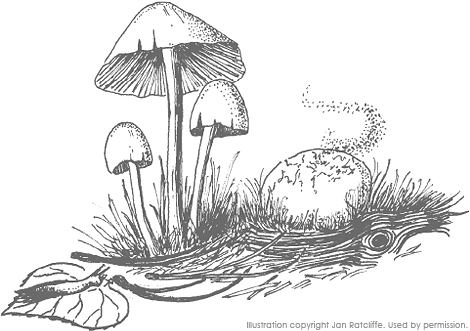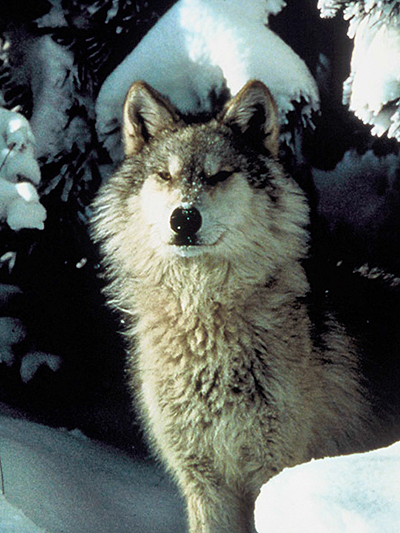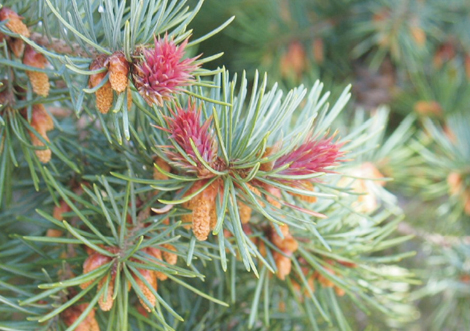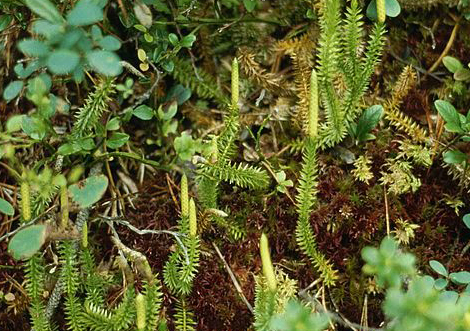PLAN Jeffco’s 40th Anniversary & Fundraiser
Date: December 2, 2012
Location: 240 Union: A Creative Grille, Lakewood, CO
ANNIVERSARY BASH BEST EVER, TAKE OVER 240 UNION FOR THE NIGHT!
It’s a rare occasion when so many supporters of Jefferson County Open Space come together in friendship and celebration, but that’s what happened at PLAN Jeffco’s 40th Anniversary Dinner & Fund-raiser. That Sunday evening, December the 2nd, saw this gathering at the 240 Union Restaurant in Lakewood. Aptly named, that night the restaurant played host to some 220 people, all of whom had come to celebrate 40 years of open space preservation in Jefferson County, and to hear the keynote speaker, Ed Bangs, talk about his 22 years of experiences as the Northern Rockies Wolf Reintroduction coordinator.
At the door, ready to greet revelers as they signed in and collected their name badges, were PLAN Jeffco long-timers and Board Members Bette & David Seeland, Ann Bonnell, and John Litz. Just around the corner, Don Moore was sharing space with “Save the Mesas” at the information and membership signup table.
Past and current members of the Open Space Advisory Committee were present to help celebrate the occasion, as were many members of the JeffCo Open Space Staff. Greg Stevinson, past Chair of OSAC, and under whose guidance the acreage of Open Space grew to over 50,000 acres. Greg (seen here on the right, with Richard Zallen) has been a significant contributor to PLAN Jeffco’s efforts, and we were pleased that he was present to celebrate this, our significant anniversary.
Wolf Expert Ed Bangs Keynote Speaker Ed Bangs was the U.S. Fish and Wildlife Service’s Gray Wolf Recovery Coordinator for the northwestern United States for more than 23 years until his retirement in 2011. Prior to his position as the Gray Wolf Recovery Coordinator, Ed worked on a variety of wildlife programs on the Kenai National Wildlife Refuge in Alaska. His programs included wolf, lynx, brown and black bear, wolverine, marten, coyote, moose, bald eagle and trumpeter swan management and research, reintroduction of caribou, and land-use planning and management. He was involved with the recovery and management of wolves in Montana, Idaho, and Wyoming beginning in 1988. He led the interagency program to plan, conduct public outreach, and reintroduce wolves to Yellowstone National Park and central Idaho in the mid-1990s. “I’ve been fortunate with opportunities to examine wolf and human relationships in many other parts of the world as well, including Mongolia, Sweden, England, Japan, Italy, Spain and Africa,” explains Ed. Well published, Ed has more than 120 scientific and popular articles to his credit on a wide variety of wildlife management issues. He has given hundreds of professional and public presentations and conducted thousands of media interviews. Ed has been recognized with numerous awards, including the U.S. Dept. of Interior Meritorious Service and Distinguished Service Awards, Letter of Commendation from U.S. Department of Justice, and Distinguished Alumni Award from Utah State University, his Alma Mater. Professionally, he is still focused on human values, conflict resolution in wildlife management, and the restoration of ecological processes. On the personal front, Ed enjoys spending time with his two daughters, staying fit, bow hunting, wildlands, food, wine, dancing, travel, scuba, literature, the Arts and oceans. |
Photos
It’s been said that a picture is worth a thousand words, so in the interest of space and time, we’re going to let these pictures tell their own story:
 PLAN Jeffco long-timers and Board Members Ann Bonnell, and John Litz greet people at the door. PLAN Jeffco long-timers and Board Members Ann Bonnell, and John Litz greet people at the door. |
 JeffCo Open Space Staff Greg Stevinson, past Chair of OSAC, and under whose guidance the acreage of Open Space grew to over 50,000 acres. On the right is Richard Zallen. JeffCo Open Space Staff Greg Stevinson, past Chair of OSAC, and under whose guidance the acreage of Open Space grew to over 50,000 acres. On the right is Richard Zallen. |
|
 CEAVCO technicians worked all afternoon to make 240 Union ready for the evening event. CEAVCO technicians worked all afternoon to make 240 Union ready for the evening event. |
 The 240 Union staff set up the entire restaurant for the event, complete with Christmas-themed decorations. The 240 Union staff set up the entire restaurant for the event, complete with Christmas-themed decorations. |
|
 Bette Seeland and Ken Foelske register Pat Keller at the door, with John Litz looking on. Bette Seeland and Ken Foelske register Pat Keller at the door, with John Litz looking on. |
 The Silent Auction room was set up for easy browsing of all the artwork and fun stuff. The Silent Auction room was set up for easy browsing of all the artwork and fun stuff. |
|
 Ralph Schell (former Director of Open Space & current County Administrator), Casey Tighe (recently elected to the Board of County Commissioners) and wife Laura, and Tom Hoby (current Director of Parks & Open Space) gather for a photo in 240 Union’s famous Wine Room. Ralph Schell (former Director of Open Space & current County Administrator), Casey Tighe (recently elected to the Board of County Commissioners) and wife Laura, and Tom Hoby (current Director of Parks & Open Space) gather for a photo in 240 Union’s famous Wine Room. |
 Some of the offerings in the Silent Auction room elicited vigorous bidding. Some of the offerings in the Silent Auction room elicited vigorous bidding. |
|
 Michelle Poolet, PJ Board member, takes a break and samples the excellent food and wine – at 240 Union, we expected no less! Michelle Poolet, PJ Board member, takes a break and samples the excellent food and wine – at 240 Union, we expected no less! |
 Families and interest groups were able to reserve entire tables for the event, thus ensuring good seating and a good view of the evening speakers. Families and interest groups were able to reserve entire tables for the event, thus ensuring good seating and a good view of the evening speakers. |
|
 The Silent Auction closed after dinner; Vera had to remind everyone to get their final bid in, or lose out on that precious what-not. The Silent Auction closed after dinner; Vera had to remind everyone to get their final bid in, or lose out on that precious what-not. |
 Margot Zallen, chief PJ’er told the history of our team. Margot Zallen, chief PJ’er told the history of our team. |
|
 |
Ed Bangs was, for 22 years, the US Fish & Wildlife Service’s Grey Wolf Recovery Coordinator for the northwestern US. He was involved with the recovery and management of wolves in Montana, Idaho, and Wyoming beginning in 1988. He led the interagency program to plan, conduct public outreach, and reintroduce wolves to Yellowstone National Park and central Idaho in the mid-1990s. Read more about Ed in the High Country News. |
|
 Ed talks with Bruce Rosenlund about aspects of his work. Ed talks with Bruce Rosenlund about aspects of his work. |
 We say as we raise a glass to wish you all that is right. Thank you so much for your support! We say as we raise a glass to wish you all that is right. Thank you so much for your support! |
|
|
PLAN Jeffco 40th Anniversary Presentation by PLAN Jeffco Chairperson, If you are unable to view content in the frame below,
With us today are many of those ordinary citizens who joined together in 1972 to do something extraordinary—convince the voters of Jefferson County to tax themselves so we could conserve fast disappearing open spaces. All of those who are founding Plan Jeffco members please stand. Did you know that that our little ½ percent tax has brought in ¾ of a billion dollars since 1972, with $240 million going directly to the cities and over $500 million going to Jefferson County? And the best part is that over 53,000 acres of land has been preserved with over 200 miles of trails constructed. Thank you all. There are others to be acknowledged. Please stand when I call your name. But hold any applause until after the introductions. Joining us today are Faye Griffin and Don Rosier, our County Commissioners, Ralph Schell, the County Administrator and former Open Space Program Director, Ellen Wakeman, County Attorney, Tom Hoby, Director of the Open Space Program, and his staff, former Program Director Ray Prinz, current and former Open Space Advisory Committee (OSAC) members, Pete Roybal, Lakewood City Council, Marjorie Sloan, the Mayor of Golden, Golden City Councilwomen Marcie Miller and Saoirse Charis-Graves and Casey Tighe, our newly elected Commissioner. PLAN Jeffco’s formation began in 1971 after a League of Woman Voters study concluded that the best way to conserve those fast disappearing open lands was for the county to buy them and to conserve them. Carol Karlin and Mike Moore began organizing us in the fall of 1971. P J was incorporated in March, 1972. We had a lot to do, write a resolution for a ballot issue that not only would fund acquisitions but would set the rules for their permanent protection, would convince conservative commissioners to put a tax increase on the ballot and establish OSAC, the Open Space Advisory Committee, with its citizen representatives and to sell the idea to the voters. Eventually, with the help of hundreds of high school students we doorbelled 96% of the county with this brochure (slide #5) and 55% of the voters said YES to their new tax. We helped Jefferson County get the program started and then hibernated until 1978 when 3 ballot issues to revise the original Open Space Resolution that we believed were harmful to the program were approved to go to the voters. PLAN Jeffco was not able stop those issues from getting on the ballot. But the voters agreed with us and rejected all three. Then in 1980, after the county settled a federal lawsuit on unconstitutional conditions at the old jail, the county decided to sell the voters on the idea of taking ½ of the Open Space revenues to build a new jail. PLAN Jeffco really organized to defeat this and two other ballot issues. The county sued some of us personally for requesting the county to tell both sides of the of the story when promoting the jail issue. PLAN Jeffco counter sued and the court eventually agreed with us. The jail issue failed and the hard feelings it generated between PLAN Jeffco and Jefferson County remained for several years. The one ballot issue that was approved in 1980 allowed the Open Space funds to be used for “recreational capital improvements”. This new authority led to Jefferson County deciding to build and manage an active recreational program at Clement Park. The recreation districts went ballistic over the county going into the recreational business. At the same time there was a big controversy over a request for Open Space funds to be used to build a cultural center/theater on the existing Open Space lands at Elk Meadow Park in Evergreen, which PLAN Jeffco strongly opposed. To resolve this Pandora’s Box dilemma regarding how Jefferson County should exercise it new authority to spend funds for “recreational capital improvements”, we went to the County Commissioners and asked them to form an ad hoc group to deal with these issues. A facilitator from Keystone met with a group of us, including representatives from the cities, recreation districts, Westernaires, and others for over a year. The ad hoc group agreed on a set of recommendations which were accepted by the County Commissioners, who told us that these saved the program. Based on the committee’s recommendations, Jefferson County agreed to not to get into the park and recreation business, to focus on land acquisition and to create a joint venture program that has provided over $50 million in grants or matching funds to the cities and recreation districts. These helped fund projects like the Wheat Ridge Recreation Center and the Evergreen Lake House. In the 1980’s the savings and loan crisis resulted in scores of developers offering to sell their land and many worthy purchases were made, like Apex Park. But there was no overall plan or set of priorities. So PLAN Jeffco did what it has frequently done, held a workshop attended by some OSAC members. They were impressed with the results and held their own workshop which led to the famous Black Book which identified five scenic acquisition priorities, Bear Creek Canyon, Clear Creek Canyon, the north and central mountain backdrop and North Table Mountain and five natural area priority areas: Ralston Buttes, Centennial Cone, Cathedral Spires, Dear Creek at the Hogback and Ralston Creek. These priority lands have almost all been acquired. The Black Book also contains plans for mile of trails to be constructed. In 1992 PLAN Jeffco formally proposed that all of Clear Creek Canyon be purchased, the first time citizens asked Jefferson County Open Space to buy a specific parcel. Although, staff complained that there were too many owners to deal with, this initiative was approved by OSAC and the County Commissioners. The final result is that all but one piece at the mouth of the Clear Creek Canyon is now conserved. But this did not happen until PLAN Jeffco and others successfully fought against the Goltra quarry proposed for the north side of the canyon. This was one of our many successful cooperative efforts. In 1992, another cooperative effort prevented a land trade proposed by Western Mobile for Open Space land near the quarry at Heritage Square for its land on North Table Mountain. Ten years later new owners came back with a better trade which PLAN Jeffco helped negotiate. That resulted in Jefferson County Open Space acquiring 400 acres on North Table Mountain which is almost all of the undeveloped land on the mesa. In 2005, while Open Space staff was working on the plans for trails for North Table Mountain, bikers and preservationists were hotly disputing the future use of North Table Mountain which contains valuable native grass lands. PLAN Jeffco intervened, formed a “team of rivals” with bikers, hikers, equestrians, wildlife biologist, native plant expert, and an Open Space staff person. We had scientific studies carried out and met several times a month for over a year. All this to develop a proposal for OSAC. Most of which was adopted. In 2000, Plan Jeffco proposed another large land conservation initiative which was accepted. That initiative called for the conservation of the Rocky Flats ecosystem because of its wonderful scenic and natural values. Our latest related effort was PLAN Jeffco’s 2011 involvement in the NEPA process relating to disposal of a strip of land on the east side of the Rocky Flats Refuge for a tollway. PLAN Jeffco also joined in the successful fight against NIKE’s plans for building on top of South Table Mountain and joined in the effort to finally conserve those lands. We were not as successful in our joint efforts to prevent the super tower on Lookout Mountain. In the late 1990’s, realizing that land prices were skyrocketing, interest rates were plummeting and key lands were again threatened, PLAN Jeffco held another workshop. The solution we proposed was for the county to issue bonds to provide additional funds immediately for Open Space acquisitions. The two County Commissioners in attendance were very concerned about borrowing money. One of them told me that they are Republicans and we don’t borrow. But after seeing how this could be achieved, they agreed this was a good idea. And the SOS bond campaign was born. Many of us in this room can claim credit for more than 73% of voters finally voting yes to approve the bond issue. It was very clear that Jefferson County Open Space program is now sacred to the overwhelming majority of our citizens. When some again began to question the economic impact of taking all these Open Space lands off the tax roles, PLAN Jeffco convened a conference focusing on this issue. Our many speakers from John Crompton, a professor at Texas AM, from the Jefferson Economic Council, the Colorado Land Trust and others, all concluded that the Open Space program and its land conservation was a powerful economic benefit to the county. I am going to end this retrospective and turn to PLAN Jeffco’s focus for the next 40 years: ACQUISITION—The concerns that drove the PLAN Jeffco to be created in 1972 are even more evident today. We need to continue to focus on acquiring more of what remains of our open lands, finding willing sellers and encouraging new developments to focus on areas near light rail and in rejuvenating the decaying areas in our cities. And of course there is the 4,700 acres at the mouth of Clear Creek Canyon that must be purchased to finish the conservation of this awe inspiring canyon. (slide #35) PURSUE ADDITIONAL FUNDING—More funding is needed, especially during the next 9 years while the SOS bonds are still being paid off. We will continue to support the Open Space Programs requests for GOCO and other grants. We encourage the creation of a revolving fund to help local land trusts pay the upfront costs of conservation easements. These easements are conserving many undeveloped parcels in both the cities and mountain areas. And in 9 years we may again be looking at another bond campaign. (slide #36) WORK WITH PARTNERS—Of course we will continue to work with the County Commissioners and the Jeffco Open Space Program as we have historically. We will continue to work with local land trusts, such as MALT, CCLC and others. And when the next NIKE or Goltra quarry is proposed we’ll be there to join with other groups in opposition. (slide #37) CONTINUED PROTECTION—It is essential to pass on the land conservation ethic to the next generations. None of us want voters in 2042 to be presented with a ballot issue to sell some of our Open Space lands or to eliminate the Jefferson County Open Space Program because it’s cheaper to build on undeveloped land. (slide #38) We all know that kids and their families are often too busy going from soccer, to Little League, to gymnastics and when at home kids spend more time on their computers that then spend sleeping. Getting diverse families and their kids into the outdoors and having fun doing it, is how many experts believe is the way to foster a continued land conservation ethic. To this end we are working with Denver Mountain Parks, Open Space, GOCO, and the Jefferson County Open Space Foundation to raise $100,000 to increase outdoor use by kids and their families. You’ll be hearing more about this later this winter. Let me show you what could have happened and what could happen. Just think of the real past and future threats to our hogbacks. Instead of being part of our scenically valued foreground, they just as easily could be gravel pits. (slide #39-40) This could have been or could become the fate of the Table Mountains and any of our mountain canyons. Just think what a good spot Elk Meadow is for a new Walmart and for homes conveniently to be built behind this new shopping center. (slide #41-42) Just think about how centrally located Crown Hill Park is and how convenient it would be for a shopping center. (slide #43-44) And last think about the great views that condo owners would get if they could build up the slopes of our mountain backdrop. Just think of all the property taxes all these developments on our open space lands would generate. (slide #45-46) We can’t let this happen and that’s why PLAN Jeffco is going to stick around for the next 40 years. We encourage you to not only join PLAN Jeffco but to work with us. Come to our board meetings held the 4th Thursday evening of every month. Go to our web site, www.planjeffco.org to find out more. Now to our key note speaker, Ed Bangs, a world renowned expert on grey wolves, their biology, their habitat, and the love/hate relationship that we humans have with this charismatic mega fauna. Ed was the Grey Wolf Recovery Coordinator in Western U.S. for U.S. Fish and Wildlife Service for 23 years and was intimately involved in the reintroduction of wolves into Yellowstone National Park and Central Utah. His work during and since the reintroductions resulted in the eventual recovery of this population of wolves which by the 1930’s had been purposefully eliminated. Enough of me talking about my former clients, Ed and the wolves. Let’s welcome Ed Bangs. |



























 “You will begin to think that I manufacture pines at my pleasure.” New species were, in those days, more abundant than botanists.
“You will begin to think that I manufacture pines at my pleasure.” New species were, in those days, more abundant than botanists.


